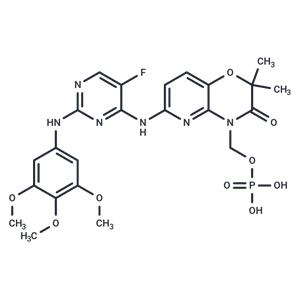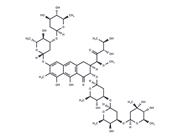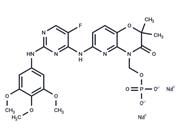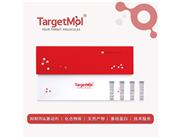| Name | Fostamatinib |
| Description | Fostamatinib (R788)(IC50 of 41 nM), which is a prodrug of the active metabolite R406, is a Syk inhibitor. It does not work on Lyn. |
| Cell Research | Cultured human mast cells (CHMC) are derived from cord blood CD34+ progenitor cells and grown, primed, and stimulated and shown in supplemental data. Before stimulation, cells are incubated with R788 or DMSO for 30 minutes. Cells are then stimulated with either 0.25 to 2 mg/mL anti-IgE or anti-IgG or 2 μM ionomycin. For tryptase measurement, ∼1500 cells per well are stimulated for 30 min in modified Tyrode's buffer. For LTC4 and cytokine production, 100,000 cells per well are stimulated for 1 or 7 hours, respectively. Tryptase activity is measured by luminescence readout of a peptide substrate, and LTC4 and cytokines are measured using Luminex multiplex technology. (Only for Reference) |
| Kinase Assay | Fluorescence polarization kinase assay and Ki determination: The fluorescence polarization reactions are performed. For Ki determination, duplicate 200-μL reactions are set up at eight different ATP concentrations from 200 μM (2-fold serial dilutions) in the presence of either DMSO or R788 at 125, 62.5, 31.25, 15.5, or 7.8 nM. At different time points, 20 μL of each reaction is removed and quenched to stop the reaction. For each concentration of R788, the rate of reaction at each concentration of ATP is determined and plotted against the ATP concentration to determine the apparent Km and Vmax (maximal rate). Finally the apparent Km (or apparent Ki/Vmax) is plotted against the inhibitor concentration to determine the Ki. |
| In vitro | In rheumatoid arthritis models, Fostamatinib significantly reduces inflammatory mediators such as TNF-alpha, IL-1, IL-6, and IL-18, thereby diminishing inflammation and bone degeneration. It effectively inhibits BCR signaling in vivo, leading to decreased proliferation and survival of malignant B cells, and notably prolongs the survival of treated animals. Oral administration of Fostamatinib in reverse passive Arthus reaction and dual-antibody-induced arthritis mouse models reduces immune complex-mediated inflammation. |
| In vivo | In human adipocytes, macrophages, and neutrophils, Fostamatinib specifically inhibits FcγR signaling. It induces apoptosis in most DLBCL cell lines. Fostamatinib (EC50=56 nM) inhibits anti-IgE mediated CHMC degranulation in a dose-dependent manner. Additionally, it inhibits the production and release of LTC4, cytokines, and chemokines, including TNFα, IL-8, and GM-CSF, induced by anti-IgE. |
| Storage | Powder: -20°C for 3 years | In solvent: -80°C for 1 year | Shipping with blue ice. |
| Solubility Information | H2O : < 1 mg/mL (insoluble or slightly soluble)
Ethanol : < 1 mg/mL (insoluble or slightly soluble)
DMSO : 107 mg/mL (184.3 mM)
|
| Keywords | Inhibitor | Spleen tyrosine kinase | Cluster of differentiation antigen 135 | Fms like tyrosine kinase 3 | CD135 | inhibit | Fostamatinib | FLT3 | Syk | R 788 | R-788 |
| Inhibitors Related | Sorafenib | Theobromine |
| Related Compound Libraries | Kinase Inhibitor Library | Tyrosine Kinase Inhibitor Library | EMA Approved Drug Library | Anti-Viral Compound Library | Inhibitor Library | FDA-Approved Drug Library | Anti-Cancer Approved Drug Library | Ion Channel Targeted Library |

 United States
United States



